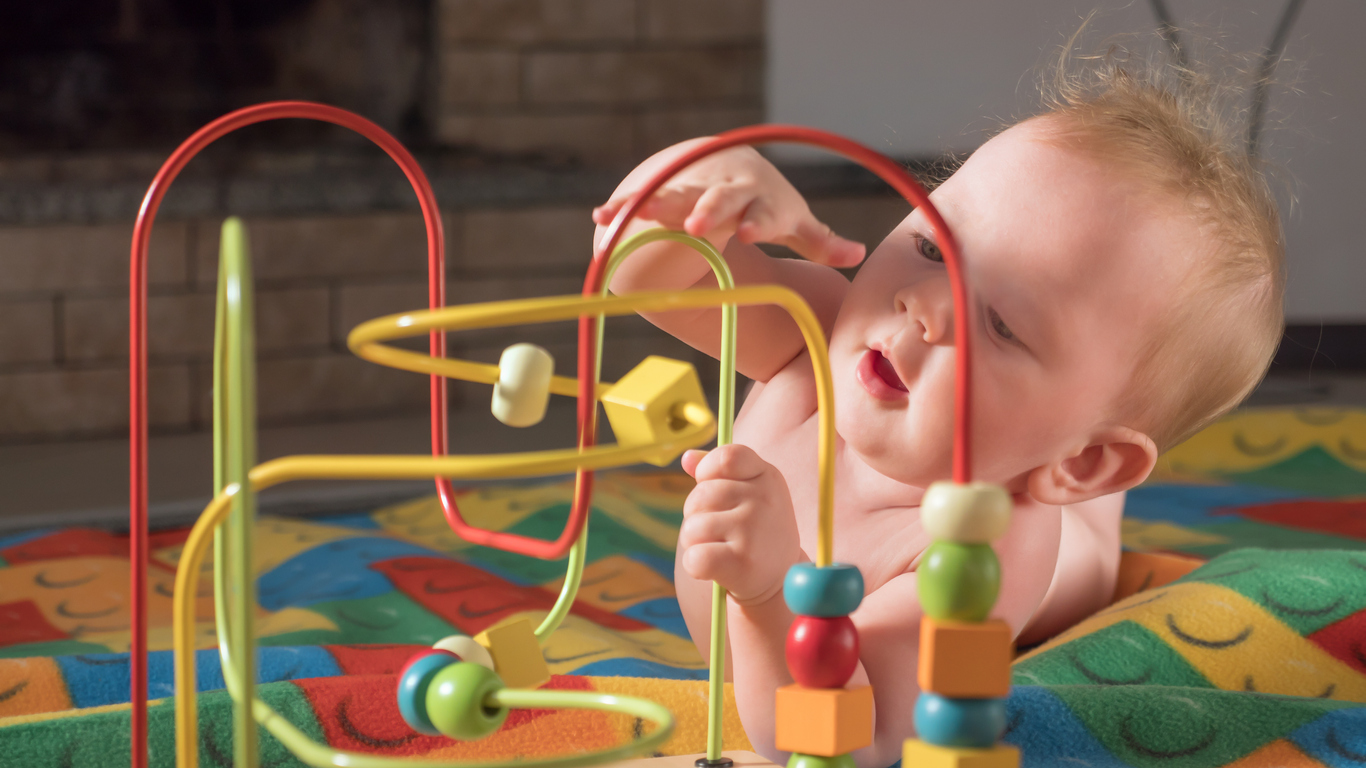When Do Babies Hold Their Heads Up? Stages of Head Control

One of the first things new parents learn when their little one arrives is how to hold the baby. Specifically, it’s about cradling in our arms while supporting their tiny necks.
Babies typically can start to hold their own heads up around 4 months of age. Regular tummy time can help your baby develop head and neck control and reach this important milestone.
As you enter the months of sleepiness nights, diaper changes and feeds, you may be wondering when you can stop holding your baby this way and whether they have any physical development delays.
Read on to learn about the common stages of motor skill growth and development in babies, when you should expect your baby to start holding their head up on their own and the different milestones to watch for.
Related: Getting Your Baby to Sit Up on Their Own
When Do Babies Hold Their Heads Up?
According to the Centers for Disease Control and Prevention (CDC), one of the movement and physical development baby milestones is to be able to hold their head steady without support when you are holding them at 4 months of age.
You will probably see this when you put your baby on its tummy; in this position, it will lean on its elbows and forearms, lift its head and chest up and hold it steady for a little while.
Grab your phone ready to capture this big moment. Your baby has just reached a developmental milestone. They can now look in any direction they want!
It is important to remember that although this is an important milestone, your baby may reach it before or after the 4 months mark. Everyone develops at their own pace. Be sure to speak with your pediatrician at your regular check-ups about any concerns you may have about your baby’s development.
When to Stop Supporting a Baby’s Head and Neck
In the first months after your little one is born, their neck muscles aren’t developed enough to support the weight of their own head.
Therefore, it’s crucial to support a newborn baby’s neck every time you pick them up, hold them and when putting them down. Make sure their head doesn’t flop from front to back or side to side when carrying them.
Practice Self-Supporting Baby’s Head Around 4 Months

Around the 4 months mark, start paying attention to how much they can hold their heads without support. Place them on their bellies and watch whether they can prop themselves up on their elbows while holding their heads steady and looking around.
Once they are able to do this confidently, you can stop supporting their head and neck when carrying them. Although your baby can do this, it’s important to never use forceful movements when lifting and moving your baby.
Baby Head Control Milestones by Month
Here are some common baby head and neck control major milestones by month to help you assess whether your baby is developing normally. Remember, your baby is unique and learns at their own speed.
Don’t fret if your baby hasn’t reached a milestone by a certain month. Be patient. Your baby is learning a lot in a very short amount of time. You know your child the best. However, according to the American Academy of Pediatrics (AAP), if you notice any of the following signs, it’s important to bring this up with your pediatrician:
- Baby is not using one part or side of their body
- Baby is no longer doing something they were able to do before
- Baby’s body and muscles are especially floppy
- Baby’s body shakes more than typical
Even if you don’t see these signs, be sure to talk to your pediatrician about any concerns you have about your baby.
Ask questions even if you think they’re silly. Healthcare providers have seen and heard a lot; they will give you the best information about your child.
Learn more about the different physical milestones your baby goes through in their first year with our Printable Month-by-Month Developmental Milestone Chart!
1 Month
When they are born, their neck muscles aren’t very strong. Therefore, they don’t have much head and neck control; however, they can move their heads from left to right and right to left.
If you are breastfeeding, you’ll notice their “rooting” reflex allows them to turn their head towards the nipple. Change positions and see their head turn to the other side.
2 Months
During tummy time, your baby at 2 months of age can lift their heads upright for very short periods. They’ll be able to move both their arms and legs freely. The baby starts to open up their hands from their tight little fists.
3 Months
At this age, their bodies begin straightening out. Your baby will start to kick more as their leg muscles strengthen. All that practice inside of mom’s belly is now showing outside the womb.
With stronger leg muscles, they may begin to start to roll over. Never leave your baby on the bed, changing table or other furniture that they can roll off of.
4 Months
All those months of tummy time will be put to use as it helps strengthen your baby’s neck muscles and develop control. Your baby can push up onto their elbows and forearms while lifting their chest and head up. They can hold their own heads steady without support.
6 Months

At 6 months of age, your baby can roll from tummy to back. When they are on their tummies, they can push themselves up with straight arms. They can lean on their hands for support while they are in the sitting position.
Tummy Time and Tips for Helping Head Control in Babies
The AAP recommends that on the day parents arrive home from the hospital, they do tummy time with their babies. This helps them increase the upper body strength in their neck and shoulder muscles which will help in the development of motor skills such as head and neck control, rolling, sitting, pulling up, crawling, standing, walking and climbing.
Supervised tummy time involves placing a baby on their bellies on the floor or a tummy time playmat and playing with them.
The AAP recommends doing this two to three times a day, starting from 3 to 5 minutes. Aim for longer periods and gradually increase the frequency as your baby gets better.
Some babies do not enjoy tummy time and may cry while placed on their bellies. Here are some tips to help make tummy time a little easier and more enjoyable for your baby:
- Put their favorite toy in an area that is close enough for them to reach. This gives them something to focus on during tummy time.
- Lie down beside your baby during tummy time so they can see you eye-to-eye. Talk, sing, play, and make encouraging sounds to help make the experience more fun.
- Place your baby on your chest while you’re laying down. Be sure to hold onto your baby so it can’t fall off.
- Get a mirror, and place it in a position where your baby can see their reflection during tummy time. Looking at themselves can be a helpful distraction.
Babies should never sleep on their stomachs to reduce the risk of Sudden Infant Death Syndrome (SIDS). Always supervise your baby during tummy time.

